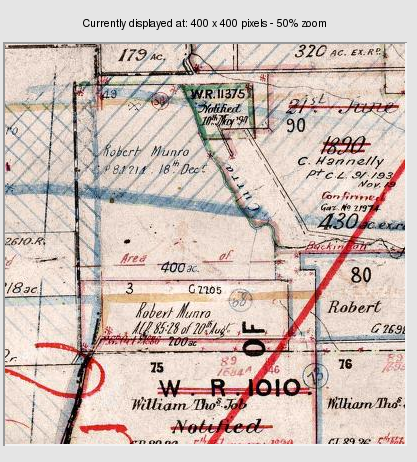


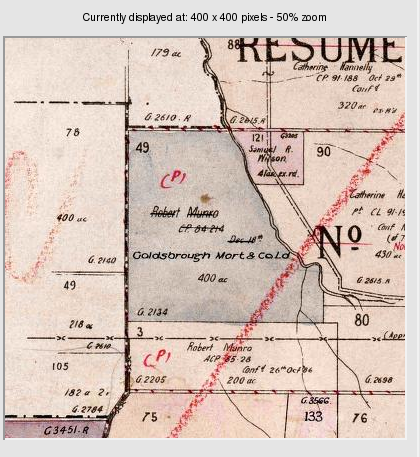
Robert Munro has borrowed from the Goldsbrough Mort company and paid out the CP, converting to freehold. The property is in the name of the mortgagee because it is old system title. New system title or torrens title was introduced with the Real Property Act 1862. Torrens land when mortgaged, remains in the name of the mortgagor.
Note that once land is alienated from the crown it is coloured grey and the Lands Department has no more interest in it. Land still belonging to the crown such as portion 3 below portion 49 remains pink, denoting crown land.
1917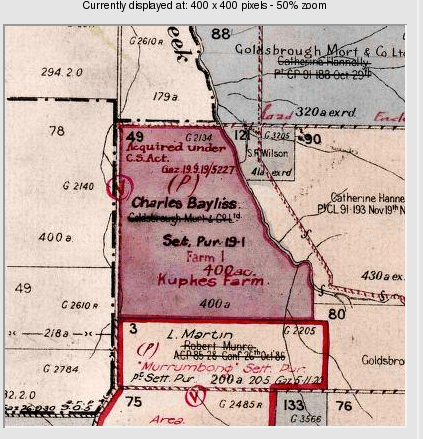
1933
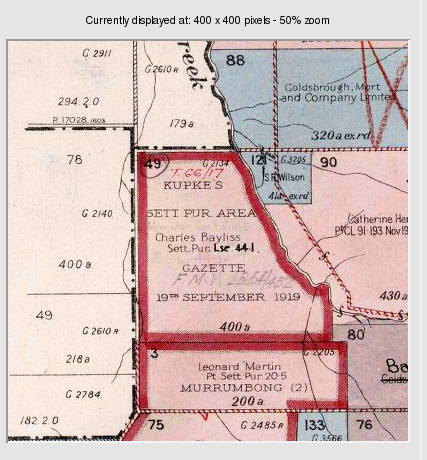
1960s
Charles
Bayliss still owns portion 49 but now as a Settlement Purchase Lease
44-1. The area was designated a Settlement Purchase Area in 1919. Note
of transfer 66/17 shows that Charles Bayliss sold the
property in 1966. The name of the new owner is available from the local
Land Board Office.
To bring the historical record up to date it is necessary to
examine the current map at the Land Board Office. This shows that it
was sold in 1997 and subsequently converted to freehold.
See
identification rural
PARISH
MAPS - HISTORY EXAMPLE
The Department has set about
preserving old parish maps. This is good news for those concerned with
the history of land settlement. The following is a case study of
portion 49 parish Catombal showing how the old maps can be used for
searching land ownership and crown tenures.
Original Crown grant to Robert Munro
1881



Robert Munro has borrowed from the Goldsbrough Mort company and paid out the CP, converting to freehold. The property is in the name of the mortgagee because it is old system title. New system title or torrens title was introduced with the Real Property Act 1862. Torrens land when mortgaged, remains in the name of the mortgagor.
Note that once land is alienated from the crown it is coloured grey and the Lands Department has no more interest in it. Land still belonging to the crown such as portion 3 below portion 49 remains pink, denoting crown land.
1917
1933

Charles
Bayliss still owns portion 49 but now as a Settlement Purchase Lease
44-1. The area was designated a Settlement Purchase Area in 1919. Note
of transfer 66/17 shows that Charles Bayliss sold the
property in 1966. The name of the new owner is available from the local
Land Board Office.
1970
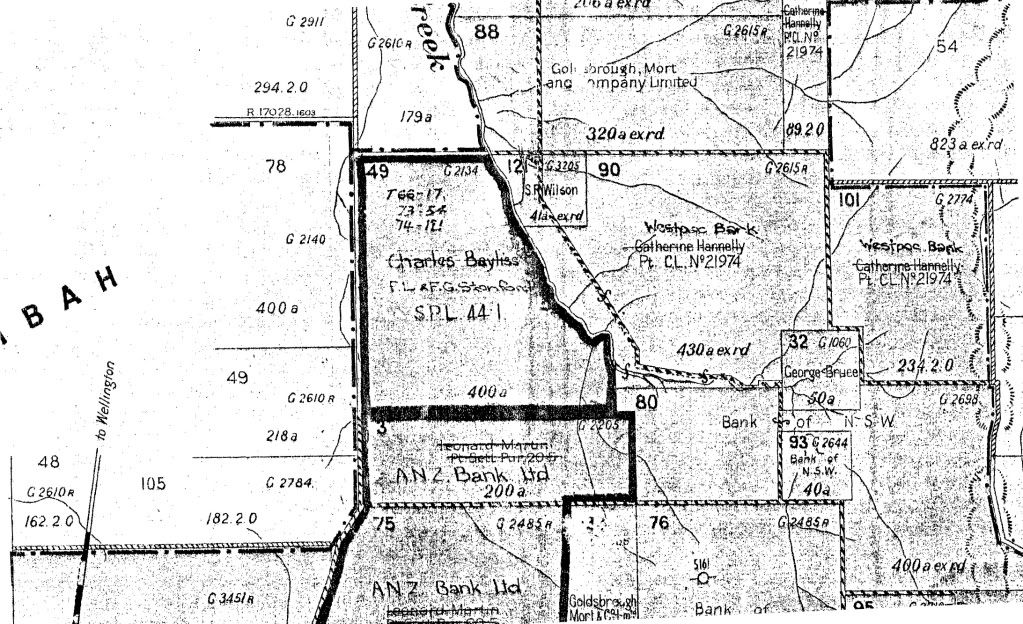
The
parish map as it exists today. It shows that there has been to more
transfers in 1973 and 1974. The last recorded owners are FL and FG
Stanford. To bring the historical record up to date it is necessary to
examine the current map at the Land Board Office. This shows that it
was sold in 1997 and subsequently converted to freehold.
See
identification rural
CONTRACTS
AND DEPOSITS
If
you want to buy a home, land or
investment property you’ll have to sign a sale contract. The legal
work involved in preparing the sale contract, mortgage and other
related documents, is called conveyancing. It’s possible to do your
own conveyancing, however, most people get a licensed conveyancer or
solicitor to do the work for them.
The
sale contract
By
law, a residential property can not
be put on the market until a sale contract has been been drawn up.
You have the right to examine the contract at any time once a
property is on the market. If a particular property interests you,
get a copy of the sale contract as soon as possible so you can ask
your solicitor or conveyancer to review it. You should have this done
before signing a sale contract.
Exchanging
contracts and paying a
deposit
Exchanging
sale contracts is the legal
part of buying a home. Before exchange, the agreement is usually just
verbal and not binding. Up until you exchange contracts either you or
the vendor have the right to change your minds.
After
you have discussed the contract
with your solicitor or licensed conveyancer and all the proper
inquiries have been made, and after all the financial arrangements
are in place, you will be ready to exchange contracts. There will be
two copies of the sale contract: one for you and one for the vendor.
You each sign one copy before they are swapped or
CONTRACTS
AND DEPOSITS
If
you want to buy a home, land or
investment property you’ll have to sign a sale contract. The legal
work involved in preparing the sale contract, mortgage and other
related documents, is called conveyancing. It’s possible to do your
own conveyancing, however, most people get a licensed conveyancer or
solicitor to do the work for them.
The
sale contract
By
law, a residential property can not
be put on the market until a sale contract has been been drawn up.
You have the right to examine the contract at any time once a
property is on the market. If a particular property interests you,
get a copy of the sale contract as soon as possible so you can ask
your solicitor or conveyancer to review it. You should have this done
before signing a sale contract.
Exchanging
contracts and paying a
deposit
Exchanging
sale contracts is the legal
part of buying a home. Before exchange, the agreement is usually just
verbal and not binding. Up until you exchange contracts either you or
the vendor have the right to change your minds.
After
you have discussed the contract
with your solicitor or licensed conveyancer and all the proper
inquiries have been made, and after all the financial arrangements
are in place, you will be ready to exchange contracts. There will be
two copies of the sale contract: one for you and one for the vendor.
You each sign one copy before they are swapped or